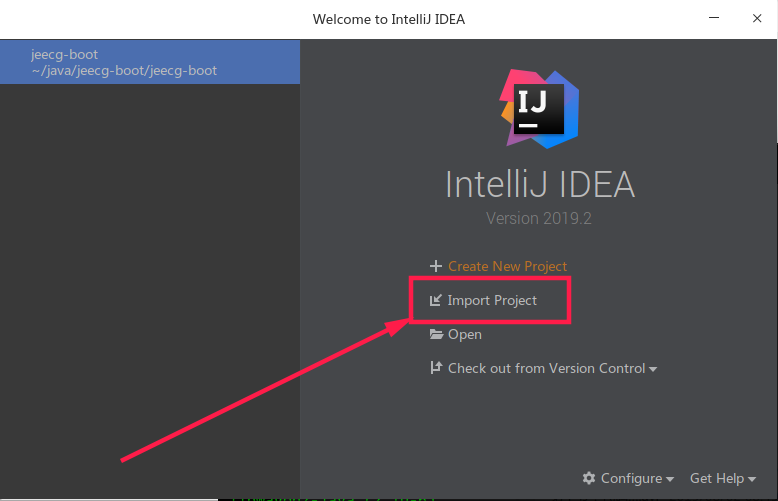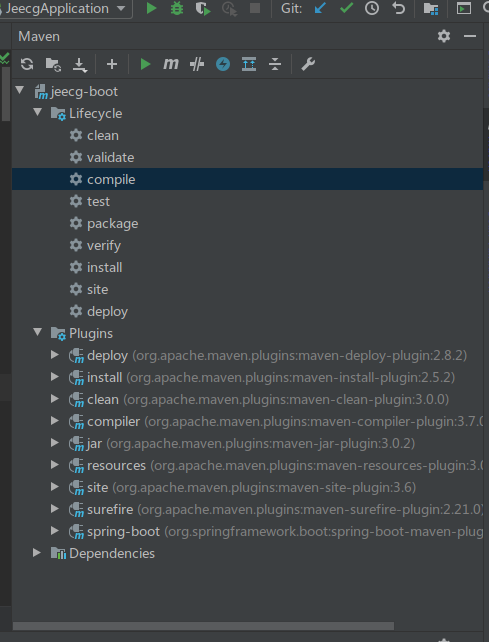[java][JEECG] Maven settings.xml JEECG项目初始化 RouYi settings.xml配置
好吧一下是经验之谈,原本这些坑不应该躺的,从头看手册完全可以避免这些。
懒得整理了,看懂了就看,看不懂自己琢磨JEECG的帮助文档去,不过嘛我喜欢用Intelij IDEA,他里面都是别的IDE,不喜欢那个。哈哈哈
这里是注意事项:
JEECG一定要使用import Project 方式导入项目,千万别OPEN pom.xml那个文件打开项目。


在settings.xml里面添加的内容
<mirrors>
<mirror>
<id>nexus-aliyun</id>
<mirrorOf>*,!jeecg,!jeecg-snapshots</mirrorOf>
<name>Nexus aliyun</name>
<url>http://maven.aliyun.com/nexus/content/groups/public</url>
</mirror>
</mirrors>

<?xml version="1.0" encoding="UTF-8"?> <!--
Licensed to the Apache Software Foundation (ASF) under one
or more contributor license agreements. See the NOTICE file
distributed with this work for additional information
regarding copyright ownership. The ASF licenses this file
to you under the Apache License, Version 2.0 (the
"License"); you may not use this file except in compliance
with the License. You may obtain a copy of the License at http://www.apache.org/licenses/LICENSE-2.0 Unless required by applicable law or agreed to in writing,
software distributed under the License is distributed on an
"AS IS" BASIS, WITHOUT WARRANTIES OR CONDITIONS OF ANY
KIND, either express or implied. See the License for the
specific language governing permissions and limitations
under the License.
--> <!--
| This is the configuration file for Maven. It can be specified at two levels:
|
| . User Level. This settings.xml file provides configuration for a single user,
| and is normally provided in ${user.home}/.m2/settings.xml.
|
| NOTE: This location can be overridden with the CLI option:
|
| -s /path/to/user/settings.xml
|
| . Global Level. This settings.xml file provides configuration for all Maven
| users on a machine (assuming they're all using the same Maven
| installation). It's normally provided in
| ${maven.conf}/settings.xml.
|
| NOTE: This location can be overridden with the CLI option:
|
| -gs /path/to/global/settings.xml
|
| The sections in this sample file are intended to give you a running start at
| getting the most out of your Maven installation. Where appropriate, the default
| values (values used when the setting is not specified) are provided.
|
|-->
<settings xmlns="http://maven.apache.org/SETTINGS/1.0.0"
xmlns:xsi="http://www.w3.org/2001/XMLSchema-instance"
xsi:schemaLocation="http://maven.apache.org/SETTINGS/1.0.0 http://maven.apache.org/xsd/settings-1.0.0.xsd">
<!-- localRepository
| The path to the local repository maven will use to store artifacts.
|
| Default: ${user.home}/.m2/repository
<localRepository>/path/to/local/repo</localRepository>
-->
<localRepository>/home/landv/.m2/repository/</localRepository>
<!-- interactiveMode
| This will determine whether maven prompts you when it needs input. If set to false,
| maven will use a sensible default value, perhaps based on some other setting, for
| the parameter in question.
|
| Default: true
<interactiveMode>true</interactiveMode>
--> <!-- offline
| Determines whether maven should attempt to connect to the network when executing a build.
| This will have an effect on artifact downloads, artifact deployment, and others.
|
| Default: false
<offline>false</offline>
--> <!-- pluginGroups
| This is a list of additional group identifiers that will be searched when resolving plugins by their prefix, i.e.
| when invoking a command line like "mvn prefix:goal". Maven will automatically add the group identifiers
| "org.apache.maven.plugins" and "org.codehaus.mojo" if these are not already contained in the list.
|-->
<pluginGroups>
<!-- pluginGroup
| Specifies a further group identifier to use for plugin lookup.
<pluginGroup>com.your.plugins</pluginGroup>
-->
</pluginGroups> <!-- proxies
| This is a list of proxies which can be used on this machine to connect to the network.
| Unless otherwise specified (by system property or command-line switch), the first proxy
| specification in this list marked as active will be used.
|-->
<proxies>
<!-- proxy
| Specification for one proxy, to be used in connecting to the network.
|
<proxy>
<id>optional</id>
<active>true</active>
<protocol>http</protocol>
<username>proxyuser</username>
<password>proxypass</password>
<host>proxy.host.net</host>
<port></port>
<nonProxyHosts>local.net|some.host.com</nonProxyHosts>
</proxy>
-->
</proxies> <!-- servers
| This is a list of authentication profiles, keyed by the server-id used within the system.
| Authentication profiles can be used whenever maven must make a connection to a remote server.
|-->
<servers>
<!-- server
| Specifies the authentication information to use when connecting to a particular server, identified by
| a unique name within the system (referred to by the 'id' attribute below).
|
| NOTE: You should either specify username/password OR privateKey/passphrase, since these pairings are
| used together.
|
<server>
<id>deploymentRepo</id>
<username>repouser</username>
<password>repopwd</password>
</server>
--> <!-- Another sample, using keys to authenticate.
<server>
<id>siteServer</id>
<privateKey>/path/to/private/key</privateKey>
<passphrase>optional; leave empty if not used.</passphrase>
</server>
-->
</servers> <!-- mirrors
| This is a list of mirrors to be used in downloading artifacts from remote repositories.
|
| It works like this: a POM may declare a repository to use in resolving certain artifacts.
| However, this repository may have problems with heavy traffic at times, so people have mirrored
| it to several places.
|
| That repository definition will have a unique id, so we can create a mirror reference for that
| repository, to be used as an alternate download site. The mirror site will be the preferred
| server for that repository.
|-->
<mirrors>
<!-- mirror
| Specifies a repository mirror site to use instead of a given repository. The repository that
| this mirror serves has an ID that matches the mirrorOf element of this mirror. IDs are used
| for inheritance and direct lookup purposes, and must be unique across the set of mirrors.
|
<mirror>
<id>mirrorId</id>
<mirrorOf>repositoryId</mirrorOf>
<name>Human Readable Name for this Mirror.</name>
<url>http://my.repository.com/repo/path</url>
</mirror>
--> <mirror>
<id>nexus-aliyun</id>
<mirrorOf>*,!jeecg,!jeecg-snapshots</mirrorOf>
<name>Nexus aliyun</name>
<url>http://maven.aliyun.com/nexus/content/groups/public</url>
</mirror> </mirrors> <!-- profiles
| This is a list of profiles which can be activated in a variety of ways, and which can modify
| the build process. Profiles provided in the settings.xml are intended to provide local machine-
| specific paths and repository locations which allow the build to work in the local environment.
|
| For example, if you have an integration testing plugin - like cactus - that needs to know where
| your Tomcat instance is installed, you can provide a variable here such that the variable is
| dereferenced during the build process to configure the cactus plugin.
|
| As noted above, profiles can be activated in a variety of ways. One way - the activeProfiles
| section of this document (settings.xml) - will be discussed later. Another way essentially
| relies on the detection of a system property, either matching a particular value for the property,
| or merely testing its existence. Profiles can also be activated by JDK version prefix, where a
| value of '1.4' might activate a profile when the build is executed on a JDK version of '1.4.2_07'.
| Finally, the list of active profiles can be specified directly from the command line.
|
| NOTE: For profiles defined in the settings.xml, you are restricted to specifying only artifact
| repositories, plugin repositories, and free-form properties to be used as configuration
| variables for plugins in the POM.
|
|-->
<profiles>
<!-- profile
| Specifies a set of introductions to the build process, to be activated using one or more of the
| mechanisms described above. For inheritance purposes, and to activate profiles via <activatedProfiles/>
| or the command line, profiles have to have an ID that is unique.
|
| An encouraged best practice for profile identification is to use a consistent naming convention
| for profiles, such as 'env-dev', 'env-test', 'env-production', 'user-jdcasey', 'user-brett', etc.
| This will make it more intuitive to understand what the set of introduced profiles is attempting
| to accomplish, particularly when you only have a list of profile id's for debug.
|
| This profile example uses the JDK version to trigger activation, and provides a JDK-specific repo.
<profile>
<id>jdk-1.4</id> <activation>
<jdk>1.4</jdk>
</activation> <repositories>
<repository>
<id>jdk14</id>
<name>Repository for JDK 1.4 builds</name>
<url>http://www.myhost.com/maven/jdk14</url>
<layout>default</layout>
<snapshotPolicy>always</snapshotPolicy>
</repository>
</repositories>
</profile>
--> <!--
| Here is another profile, activated by the system property 'target-env' with a value of 'dev',
| which provides a specific path to the Tomcat instance. To use this, your plugin configuration
| might hypothetically look like:
|
| ...
| <plugin>
| <groupId>org.myco.myplugins</groupId>
| <artifactId>myplugin</artifactId>
|
| <configuration>
| <tomcatLocation>${tomcatPath}</tomcatLocation>
| </configuration>
| </plugin>
| ...
|
| NOTE: If you just wanted to inject this configuration whenever someone set 'target-env' to
| anything, you could just leave off the <value/> inside the activation-property.
|
<profile>
<id>env-dev</id> <activation>
<property>
<name>target-env</name>
<value>dev</value>
</property>
</activation> <properties>
<tomcatPath>/path/to/tomcat/instance</tomcatPath>
</properties>
</profile>
-->
</profiles> <!-- activeProfiles
| List of profiles that are active for all builds.
|
<activeProfiles>
<activeProfile>alwaysActiveProfile</activeProfile>
<activeProfile>anotherAlwaysActiveProfile</activeProfile>
</activeProfiles>
-->
</settings>
无注释
<settings xmlns="http://maven.apache.org/SETTINGS/1.0.0"
xmlns:xsi="http://www.w3.org/2001/XMLSchema-instance"
xsi:schemaLocation="http://maven.apache.org/SETTINGS/1.0.0
http://maven.apache.org/xsd/settings-1.0.0.xsd">
<localRepository>${user.home}/.m2/repository</localRepository>
<interactiveMode>true</interactiveMode>
<usePluginRegistry>false</usePluginRegistry>
<offline>false</offline> <mirrors>
<!-- mirror
| Specifies a repository mirror site to use instead of a given repository. The repository that
| this mirror serves has an ID that matches the mirrorOf element of this mirror. IDs are used
| for inheritance and direct lookup purposes, and must be unique across the set of mirrors.
|-->
<mirror>
<id>nexus-aliyun</id>
<mirrorOf>*,!jeecg,!jeecg-snapshots</mirrorOf>
<name>Nexus aliyun</name>
<url>http://maven.aliyun.com/nexus/content/groups/public</url>
</mirror> </mirrors> </settings>
来一条帆软的
<?xml version="1.0" encoding="UTF-8"?> <settings xmlns="http://maven.apache.org/SETTINGS/1.0.0"
xmlns:xsi="http://www.w3.org/2001/XMLSchema-instance"
xsi:schemaLocation="http://maven.apache.org/SETTINGS/1.0.0 http://maven.apache.org/xsd/settings-1.0.0.xsd"> <pluginGroups> </pluginGroups> <proxies> </proxies> <servers> </servers> <mirrors>
<mirror>
<id>nexus-aliyun</id>
<mirrorOf>central</mirrorOf>
<url>http://maven.aliyun.com/nexus/content/groups/public/</url>
</mirror>
</mirrors>
<profiles> <profile>
<id>fanruan</id>
<repositories>
<repository>
<id>fanruan</id>
<name>fanruan</name>
<url>http://mvn.finedevelop.com/repository/maven-public/</url>
<snapshots>
<enabled>true</enabled>
<updatePolicy>always</updatePolicy>
<checksumPolicy>warn</checksumPolicy>
</snapshots>
</repository>
</repositories>
<pluginRepositories>
<pluginRepository>
<id>fanruan</id>
<name>fanruan</name>
<url>http://mvn.finedevelop.com/repository/maven-public/</url>
<snapshots>
<enabled>true</enabled>
<updatePolicy>always</updatePolicy>
<checksumPolicy>warn</checksumPolicy>
</snapshots>
</pluginRepository>
</pluginRepositories>
</profile> </profiles> <activeProfiles> <activeProfile>fanruan</activeProfile>
</activeProfiles> </settings>
RouYi settings.xml配置
<settings xmlns="http://maven.apache.org/SETTINGS/1.0.0"
xmlns:xsi="http://www.w3.org/2001/XMLSchema-instance"
xsi:schemaLocation="http://maven.apache.org/SETTINGS/1.0.0
http://maven.apache.org/xsd/settings-1.0.0.xsd">
<localRepository>${user.home}/.m2/repository</localRepository>
<interactiveMode>true</interactiveMode>
<usePluginRegistry>false</usePluginRegistry>
<offline>false</offline> <mirrors>
<!-- mirror
| Specifies a repository mirror site to use instead of a given repository. The repository that
| this mirror serves has an ID that matches the mirrorOf element of this mirror. IDs are used
| for inheritance and direct lookup purposes, and must be unique across the set of mirrors.
|-->
<mirror>
<id>nexus-aliyun</id>
<mirrorOf>central,!ruoyi</mirrorOf>
<name>Nexus aliyun</name>
<url>http://maven.aliyun.com/nexus/content/groups/public</url>
</mirror> </mirrors> </settings>
[java][JEECG] Maven settings.xml JEECG项目初始化 RouYi settings.xml配置的更多相关文章
- java使用maven创建springmvc web项目
创建maven项目,使用maven-archetype-webapp 创建完成后首先是在pom.xml里增加maven的依赖 <dependencies> <dependency&g ...
- tomcat下的web.xml和项目中的web.xml
Tomcat 服务器中存在一个web.xml文件 在项目文件夹中同样存在一个web.xml文件 那这两个文件有什么区别呢? tomcat中的web.xml是通用的,如果不设置,那么就会默认是同tomc ...
- centos7中配置java + mysql +jdk +使用jar部署项目
centos7中配置java + mysql +jdk +使用jar部署项目 思维导图 1. 配置JDK環境 1.1下载jdk安装包 Java Downloads | Oracle 1.2 将下载j ...
- JEECG(二) JEECG框架下调用webservice java springmvc maven 调用 webservice
JEECG系列教程二 如何在JEECG框架下使用webservice 本文所使用的webservice是c#开发的 其实无论是什么语言开发的webservice用法都一样 java springmvc ...
- 500G JAVA视频网盘分享 (Jeecg社区)
http://blog.csdn.net/zhangdaiscott/article/details/18220411 csdn 排名400多名 500 G JAVA视频网盘分享(Jeecg社区 ...
- 500 G JAVA视频网盘分享(JEECG开源社区)
500 G JAVA视频网盘分享(JEECG开源社区) [涵盖从java入门到深入架构,Linux.云计算.分布式.大数据Hadoop.ios.Android.互联网技术应有尽有] [转载:h ...
- 500G JAVA视频网盘分享 (JEECG开源社区)
500 G JAVA视频网盘分享(JEECG开源社区) [涵盖从java入门到深入架构,Linux.云计算.分布式.大数据Hadoop.ios.Android.互联网技术应有尽有] J ...
- (Win10)Java,Maven,Tomcat8.0,Mysql8.0.15安装与环境配置,以及IDEA2019.3使用JDBC连接MySQL、创建JavaEE项目
之前用windows+linux的双系统,最近不怎么舒服就把双系统给卸了,没想到除了问题,导致有linux残余,于是就一狠心重装了电脑,又把Java及其相关的一些东西重新装了回来,还好当初存了网盘链接 ...
- Maven项目中的pom.xml详解【转】
什么是pom? pom作为项目对象模型.通过xml表示maven项目,使用pom.xml来实现.主要描述了项目:包括配置文件:开发者需要遵循的规则,缺陷管理系统,组织和licenses,项目的url, ...
随机推荐
- node-red 流程的导入导出
流程的导入导出 流程的导出 选中所要导出的流程,点击右上角三条杠按钮 有两个选项,导出到剪贴板和库 1. 导出到剪贴板 导出到剪贴板可以复制,粘贴到任何地方 [{,,,,,,"wires&q ...
- power shell命令添加SharePoint用户组与用户(用户为域用户)
查看SharePoint用户组 Get-PnPGroup 查看某一用户组 Get-PnPGroup -Identity "用户组名" 查看某一用户组下的所有成员 Get-PnPGr ...
- Java调用WebService方法总结(9,end)--Http方式调用WebService
Http方式调用WebService,直接发送soap消息到服务端,然后自己解析服务端返回的结果,这种方式比较简单粗暴,也很好用:soap消息可以通过SoapUI来生成,也很方便.文中所使用到的软件版 ...
- flutter 动画
AnimatedCrossFade AnimatedCrossFade让俩个子widget 交替淡入淡出. class AnimatedCrossFade1 extends StatefulWidge ...
- UML软件工程第一次实验
顶层设计 UC1诊所设备管理 UC1.1 统计设备使用情况 用况标识号 UC1.1 用况名称 统计设备使用情况 创建者 派克 创建时间 2017-9-25 参与者 客户 说明 客户需要知道自己诊所设备 ...
- Oracle 11g 服务器结构
Oracle 服务器主要又实例.数据库.程序全局区和前台进程组成. 实例可以进一步划分为系统全局区(SGA)和后台进程(PMON.SMON等)两部分,其中,SGA 使用操作系统的内存资源,而后台进程需 ...
- linux运行级
Linux有0到6个级别,分别对应/etc/rcN.d,N对应7个级别 各运行级详解 0.关机 1.单用户模式,类似于Windows安全模式 2.多用户模式 3.完整的多用户模式.标准运行级 4.不用 ...
- python代码工具小结
目录: 1.with读.写文件 (1)with读文件 (2)with写文件 2.requests爬虫 (1)get请求 (2)post请求 1.with读.写文件 (1)with读文件 (2)with ...
- ViewBag---MVC3中 ViewBag、ViewData和TempData的使用和差别-------与ViewBag+Hashtable应用例子
ViewBag 在MVC3開始.视图数据能够通过ViewBag属性訪问.在MVC2中则是使用ViewData.MVC3中保留了ViewData的使用.ViewBag 是动态类型(dynamic),Vi ...
- 更新yum源并重建缓存
原文连接 1)下载wget yum install -y wget 2)备份默认的yum mv /etc/yum.repos.d /etc/yum.repos.d.backup 3)设置新的yum目录 ...
